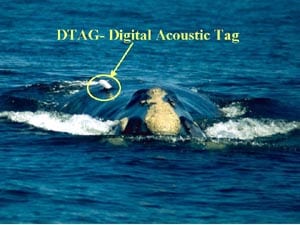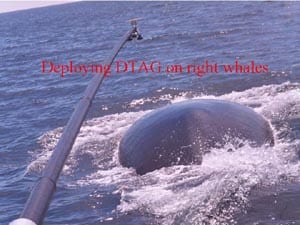Study to Assess Risk Factors of Vessel Collisions with Endangered Northern Right Whales
July 19, 2001
Scientists and engineers at the Woods Hole Oceanographic Institution (WHOI) and their colleagues will use a new digital recording tag to study and assess the risk factors of vessel collisions with the endangered Northern right whale. Less than 300 of the whales remain.
Senior Scientist Peter Tyack of the Institution’s Biology Department, who is heading the study with colleagues at the New England Aquarium, says the primary human-induced causes for right whale deaths are vessel collisions, which account for 35 percent of the deaths, and entanglement in fishing gear, which accounts for 5 percent of right whale deaths. Scientists are currently trying to save a right whale off the Massachusetts coast entangled in a fishing line.
“Right whales are so buoyant, they float to the surface,” Tyack says. “If this reduces their ability to maneuver, it may pose a risk of collision with ships. The whales can hear and localize natural sounds very well, but they have not been observed to respond to oncoming vessels.”
The study is supported by a grant from the Mitsubishi Corporation and the National Oceanic and Atmospheric Administration’s right whale research program through the National Marine Fisheries Service at NOAA. Collaborators include the International Fund for Animal Welfare and the New England Aquarium.
“We need to address questions like what age and sex classes, behavioral contexts or habitats pose the greatest risk,” Tyack adds. “What vessel characteristics, such as speed, maneuvering, and acoustic signature, pose the greatest risk? The tag will enable us to learn a lot more about how the whales respond to vessels as they get closer and may eventually help us develop an acoustic alerting system.”
The new study will focus on the behavioral perspective, using the digital acoustic recording tag to measure sound stimuli with vocal, behavioral and physiological responses. The researchers will also follow whale responses to uncontrolled vessel approaches, playbacks of natural sound, and controlled exposure to vessel noise during vessel approach. They will also assess the distribution and abundance of right whales in the western North Atlantic and collect photographs of individual whales, which can be identified by natural markings called callosities. These data will be integrated into a database to update information on population status, reproduction, mortality, human-caused scarring, and other factors.
Tyack and his colleagues note that the Northern Atlantic right whale is an endangered population, with less than 300 individuals remaining. Extinction is likely in 100 years unless reproduction increases or mortality decreases. The population is only growing at a rate of 1-2 percent, while the South Atlantic right whale population is growing at a rate of seven percent.
“Our ignorance of the reproductive behavior and the mating system of right whales is so profound that we do not even know the season and location where mating takes place,” Tyack notes. “This hinders our ability to determine the effects of disturbances like vessels and to minimize them. We hope this study will help provide data critical to understanding reproduction in ways that may point to how we can enhance the recovery of this most endangered of baleen whales.”
Tokyo-based Mitsubishi Corporation is a trading and investment company engaged in a broad range of businesses, including information technology and electronics, energy, metals, machinery, chemicals and Living Essentials. As one of the world’s most diverse business enterprises, Mitsubishi Corporation, works closely with its global clientele to develop new businesses through project coordination, sourcing of raw materials, capital investments, and global marketing and distribution.


